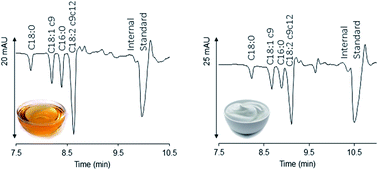A fast and validated capillary zone electrophoresis method for the determination of selected fatty acids applied to food and cosmetic purposes
Abstract
Fatty acids (FAs) are classically determined by gas chromatography (GC), but capillary electrophoresis (CE) can be used to determine the FA fingerprint in only a few minutes by employing small amounts of reagents and solvents without requiring specific columns for analysis. In this study, palmitic (C16:0), stearic (C18:0), oleic (C18:1 c9) and linoleic (C18:2 c9c12) FAs were determined in pumpkin seed oil and a moisturizing cream containing this oil by capillary zone electrophoresis under indirect ultraviolet absorption detection (CZE-UV), showing the potential of CE for FA determination in challenging matrices. The method was validated with regards to limits of detection and quantification (LOD and LOQ), linearity, accuracy and repeatability. The method may be used for the fast monitoring of FAs in food and cosmetics, and also for labelling purposes. The LOD for C16:0, C18:0, C18:1 c9 and C18:2 c9c12 were 0.03, 0.05, 0.04 and 0.04 mmol L−1, respectively, and the LOQ was 0.1 mmolL−1 for all FAs. No significant difference was found between the classical GC and this alternative method within the 95% confidence interval. Furthermore, the repeatability tests showed minor relative standard deviations for the migration time, evidencing the precision of this CZE-UV method.

- This article is part of the themed collection: Celebrating Latin American Talent in Chemistry


 Please wait while we load your content...
Please wait while we load your content...